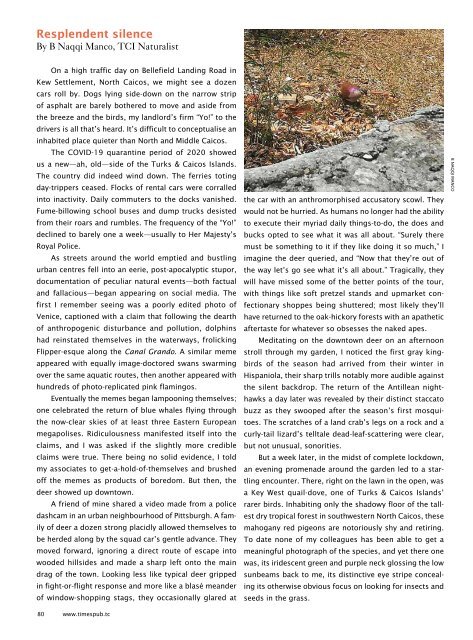Times of the Islands Summer 2020
Presents the "soul of the Turks & Caicos Islands" with in-depth features about local people, culture, history, environment, businesses, resorts, restaurants and activities.
Presents the "soul of the Turks & Caicos Islands" with in-depth features about local people, culture, history, environment, businesses, resorts, restaurants and activities.
You also want an ePaper? Increase the reach of your titles
YUMPU automatically turns print PDFs into web optimized ePapers that Google loves.
Resplendent silence<br />
By B Naqqi Manco, TCI Naturalist<br />
On a high traffic day on Bellefield Landing Road in<br />
Kew Settlement, North Caicos, we might see a dozen<br />
cars roll by. Dogs lying side-down on <strong>the</strong> narrow strip<br />
<strong>of</strong> asphalt are barely bo<strong>the</strong>red to move and aside from<br />
<strong>the</strong> breeze and <strong>the</strong> birds, my landlord’s firm “Yo!” to <strong>the</strong><br />
drivers is all that’s heard. It’s difficult to conceptualise an<br />
inhabited place quieter than North and Middle Caicos.<br />
The COVID-19 quarantine period <strong>of</strong> <strong>2020</strong> showed<br />
us a new—ah, old—side <strong>of</strong> <strong>the</strong> Turks & Caicos <strong>Islands</strong>.<br />
The country did indeed wind down. The ferries toting<br />
day-trippers ceased. Flocks <strong>of</strong> rental cars were corralled<br />
into inactivity. Daily commuters to <strong>the</strong> docks vanished.<br />
Fume-billowing school buses and dump trucks desisted<br />
from <strong>the</strong>ir roars and rumbles. The frequency <strong>of</strong> <strong>the</strong> “Yo!”<br />
declined to barely one a week—usually to Her Majesty’s<br />
Royal Police.<br />
As streets around <strong>the</strong> world emptied and bustling<br />
urban centres fell into an eerie, post-apocalyptic stupor,<br />
documentation <strong>of</strong> peculiar natural events—both factual<br />
and fallacious—began appearing on social media. The<br />
first I remember seeing was a poorly edited photo <strong>of</strong><br />
Venice, captioned with a claim that following <strong>the</strong> dearth<br />
<strong>of</strong> anthropogenic disturbance and pollution, dolphins<br />
had reinstated <strong>the</strong>mselves in <strong>the</strong> waterways, frolicking<br />
Flipper-esque along <strong>the</strong> Canal Grando. A similar meme<br />
appeared with equally image-doctored swans swarming<br />
over <strong>the</strong> same aquatic routes, <strong>the</strong>n ano<strong>the</strong>r appeared with<br />
hundreds <strong>of</strong> photo-replicated pink flamingos.<br />
Eventually <strong>the</strong> memes began lampooning <strong>the</strong>mselves;<br />
one celebrated <strong>the</strong> return <strong>of</strong> blue whales flying through<br />
<strong>the</strong> now-clear skies <strong>of</strong> at least three Eastern European<br />
megapolises. Ridiculousness manifested itself into <strong>the</strong><br />
claims, and I was asked if <strong>the</strong> slightly more credible<br />
claims were true. There being no solid evidence, I told<br />
my associates to get-a-hold-<strong>of</strong>-<strong>the</strong>mselves and brushed<br />
<strong>of</strong>f <strong>the</strong> memes as products <strong>of</strong> boredom. But <strong>the</strong>n, <strong>the</strong><br />
deer showed up downtown.<br />
A friend <strong>of</strong> mine shared a video made from a police<br />
dashcam in an urban neighbourhood <strong>of</strong> Pittsburgh. A family<br />
<strong>of</strong> deer a dozen strong placidly allowed <strong>the</strong>mselves to<br />
be herded along by <strong>the</strong> squad car’s gentle advance. They<br />
moved forward, ignoring a direct route <strong>of</strong> escape into<br />
wooded hillsides and made a sharp left onto <strong>the</strong> main<br />
drag <strong>of</strong> <strong>the</strong> town. Looking less like typical deer gripped<br />
in fight-or-flight response and more like a blasé meander<br />
<strong>of</strong> window-shopping stags, <strong>the</strong>y occasionally glared at<br />
80 www.timespub.tc<br />
<strong>the</strong> car with an anthromorphised accusatory scowl. They<br />
would not be hurried. As humans no longer had <strong>the</strong> ability<br />
to execute <strong>the</strong>ir myriad daily things-to-do, <strong>the</strong> does and<br />
bucks opted to see what it was all about. “Surely <strong>the</strong>re<br />
must be something to it if <strong>the</strong>y like doing it so much,” I<br />
imagine <strong>the</strong> deer queried, and “Now that <strong>the</strong>y’re out <strong>of</strong><br />
<strong>the</strong> way let’s go see what it’s all about.” Tragically, <strong>the</strong>y<br />
will have missed some <strong>of</strong> <strong>the</strong> better points <strong>of</strong> <strong>the</strong> tour,<br />
with things like s<strong>of</strong>t pretzel stands and upmarket confectionary<br />
shoppes being shuttered; most likely <strong>the</strong>y’ll<br />
have returned to <strong>the</strong> oak-hickory forests with an apa<strong>the</strong>tic<br />
aftertaste for whatever so obsesses <strong>the</strong> naked apes.<br />
Meditating on <strong>the</strong> downtown deer on an afternoon<br />
stroll through my garden, I noticed <strong>the</strong> first gray kingbirds<br />
<strong>of</strong> <strong>the</strong> season had arrived from <strong>the</strong>ir winter in<br />
Hispaniola, <strong>the</strong>ir sharp trills notably more audible against<br />
<strong>the</strong> silent backdrop. The return <strong>of</strong> <strong>the</strong> Antillean nighthawks<br />
a day later was revealed by <strong>the</strong>ir distinct staccato<br />
buzz as <strong>the</strong>y swooped after <strong>the</strong> season’s first mosquitoes.<br />
The scratches <strong>of</strong> a land crab’s legs on a rock and a<br />
curly-tail lizard’s telltale dead-leaf-scattering were clear,<br />
but not unusual, sonorities.<br />
But a week later, in <strong>the</strong> midst <strong>of</strong> complete lockdown,<br />
an evening promenade around <strong>the</strong> garden led to a startling<br />
encounter. There, right on <strong>the</strong> lawn in <strong>the</strong> open, was<br />
a Key West quail-dove, one <strong>of</strong> Turks & Caicos <strong>Islands</strong>’<br />
rarer birds. Inhabiting only <strong>the</strong> shadowy floor <strong>of</strong> <strong>the</strong> tallest<br />
dry tropical forest in southwestern North Caicos, <strong>the</strong>se<br />
mahogany red pigeons are notoriously shy and retiring.<br />
To date none <strong>of</strong> my colleagues has been able to get a<br />
meaningful photograph <strong>of</strong> <strong>the</strong> species, and yet <strong>the</strong>re one<br />
was, its iridescent green and purple neck glossing <strong>the</strong> low<br />
sunbeams back to me, its distinctive eye stripe concealing<br />
its o<strong>the</strong>rwise obvious focus on looking for insects and<br />
seeds in <strong>the</strong> grass.<br />
B NAQQI MANCO

















